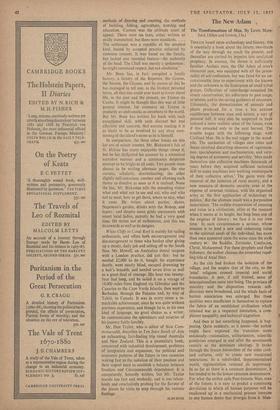The New Adam
The Transformations of Man. By Lewis Mum- ford. (Allen and Unwin, 15s.) THoucti based upon archaeology and history, this is essentially a book about the future; two-thirds of the way through we reach the present, and thereafter are carried by impetus into analytical prophecy. In essence, the theme is sufficiently familiar. Archaic man, the Old Adam of man's elemental past, was equipped with all the poten- tiality of self-realisation, but was fated for an un- conscionable time to experiment with the known and the unknown in the frustration of small tribal groups. Difficulties of interchange sustained his innate conservatism, his adherence to past usage, to taboos, and to the saving guidance of ancestors. Ultimately, the domestication of animals and plants produced for a time a less anxious equilibrium between man and nature, a sort of pastoral lull; it may also be suspected to have induced a more realistic sense of the future, even if this extended only to the next harvest. The trouble began with the following stage, with Civilised Man. He is the real nigger in the wood- pile. The nucleation of villages into cities and States involved disturbing elements of regimenta- tion, specialisation and mechanisation, and vary- ing degrees of autonomy and servility. 'Men made themselves into collective machines thousands of years before they acquired sufficient technical skill to make machines into working counterparts of their collective selves.' The gains were the removal of the isolation of rural society, and a new measure. of domestic security even at the expense of external violence, with the organised army as 'the first application of technology to politics.' But the ultimate result was a purposeless materialism. 'The sudden evaporation of meaning and value in a civilisation, often at the moment when it seems at its height, has long been one of the enigmas of history : we face it in our own time.' In such circumstances a saviour, whose mission is to lend a new and redeeming value to the spiritual needs of the individual, has more than once appeared upon the scene since the sixth century ac : the Buddha, Zoroaster, Confucius, Christ, Mohammed. For these prophets and their followers, the author chooses the somewhat repel- ling title of Axial Man.
As the city had broken the isolation of the village, and the empire that of the city, so the 'axial' religions crossed imperial and social, boundaries. A new, if still limited, sense of internationalism came into being. The province of morality and the disposition towards self- direction were broadened, and the whole basis of human association was enlarged. But these qualities were insufficient in themselves to replace the fabric of an established civilisation which retained war as a respected institution, a com- placent inequality, and technical stagnation.
And then at last something happened, is' hap- pening. Quite suddenly, as it seems—the author might have explored the transition more sedulously—rationalism, utilitarianism, scientific positivism emerged in and after the seventeenth century as the dominant ideology. It broke through the frozen hierarchies of the older civil- ised cultures, only to create new vocational restrictions. In a subdivided, departrnentalised world, regimentation retained its supremacy. In so far as there is a common denominator, it has tended to be the lowest common denominator. For what the author calls Post-historic Man, man of the future, it is easy to predict a continuing devolution in which all human purposes will be swallowed up in a mechanical process immune to any human desire that diverges from it. Man- kind will be increasingly identified with the machine; the human beings necessary to run post-historic culture will be provided at the educa- tional factory with built-in responses. Life will become a mechanically engineered coma.
All this is very sad hearing, if it is true. Happily the author does not himself believe in its inevit- ability. He finds escape in a composite World Culture .in which the new man will seek, not to impose a mechanical uniformity, but to bring about a new organic unity. A wide measure of standardisation is consistent with the release of the higher functions of society, as the reflexes release the higher functions in an organism. Coherence will be achieved, not, as in the past, by walled isolation, but by concentration on com- mon purposes, 'with a relaxation of tension again once the object is won.' So be it; the author modestly describes his vision of the future as a myth. The student ' of history may find more reassurance in the thought that, by the skin of his teeth, mankind has got by so far, and, unless he be a greater fool than the past teaches us to suspect, he will somehow get by again. But only just. A stimulating book; the summary of a historical philosophy rather than the presentation of it.
MORTIMER WHEELER















































 Previous page
Previous page